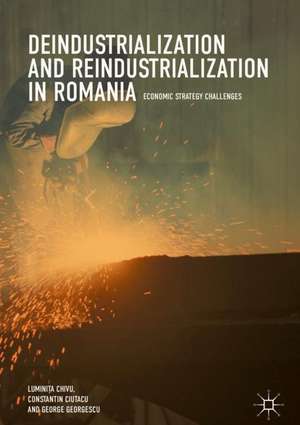Deindustrialization and Reindustrialization in Romania: Economic Strategy Challenges
Autor Luminița Chivu, Constantin Ciutacu, George Georgescuen Limba Engleză Hardback – 16 noi 2017
This book analyses the multidimensional condition of the Romanian industrial landscape, which played host to a multitude of demo-economic, financial, trade, and trans- and inter-sectoral development practices before the intense period of European deindustrialisation. The authors stress the need to recognise the economic importance of industry and renewed investment in infrastructure, tracing its impact on GDP, growth and labour productivity. With a focus on R&D, technological innovations and government funding, this volume highlights a strategy for the reindustrialisation, with consistent enablers, of Romania that can also be applied to other EU countries to ensure positive economic development in the context of new European and international policies.
Awarded the prize for best book in Economics published in the academic year 2017-2018 by the Romanian Association of Economics Faculties (AFER).
Awarded the prize for best book in Economics published in the academic year 2017-2018 by the Romanian Association of Economics Faculties (AFER).
| Toate formatele și edițiile | Preț | Express |
|---|---|---|
| Paperback (1) | 739.36 lei 38-44 zile | |
| Springer International Publishing – 25 aug 2018 | 739.36 lei 38-44 zile | |
| Hardback (1) | 788.72 lei 43-57 zile | |
| Springer International Publishing – 16 noi 2017 | 788.72 lei 43-57 zile |
Preț: 788.72 lei
Preț vechi: 961.85 lei
-18% Nou
Puncte Express: 1183
Preț estimativ în valută:
150.92€ • 157.100$ • 124.88£
150.92€ • 157.100$ • 124.88£
Carte tipărită la comandă
Livrare economică 07-21 aprilie
Preluare comenzi: 021 569.72.76
Specificații
ISBN-13: 9783319657523
ISBN-10: 3319657526
Pagini: 283
Ilustrații: XIII, 284 p. 4 illus. in color.
Dimensiuni: 148 x 210 mm
Greutate: 0.64 kg
Ediția:1st ed. 2017
Editura: Springer International Publishing
Colecția Palgrave Macmillan
Locul publicării:Cham, Switzerland
ISBN-10: 3319657526
Pagini: 283
Ilustrații: XIII, 284 p. 4 illus. in color.
Dimensiuni: 148 x 210 mm
Greutate: 0.64 kg
Ediția:1st ed. 2017
Editura: Springer International Publishing
Colecția Palgrave Macmillan
Locul publicării:Cham, Switzerland
Cuprins
Chapter 1. The National and European Context of Industrial Development.- Chapter 2. Macroeconomic Changes in Romania During the Transition Period.- Chapter 3. Privatization-Driven Transformation of Romania’s Industrial Landscape.- Chapter 4. Industrial Production Restructuring.- Chapter 5. Impacts of Romania’s Deindustrialization on Investments and the Labour Market.- Chapter 6. Industry and Industrial Policies in the European Union.- Chapter 7. Conclusions on How the Industrial Economy in Romania Should be Supported.
Notă biografică
Luminiţa Chivu is General Director of the National Institute for Economic Research 'Costin C. Kiritescu' at the Romanian Academy, Romania. Chivu has 25 years of experience in economic academic research and tertiary education, focusing on labour markets, wage policies, social dialogue, vocational training, industrial relations, working conditions, economic restructuring and competition policy.
The late Constantin Ciutacu was General Deputy Director of the National Institute for Economic Research 'Costin C. Kiritescu' at the Romanian Academy, Romania. He had more than 40 years of experience in economic academic research and tertiary education, focused on macroeconomics and economic restructuring, competition policy, labour market, wage policies, social dialogue, industrial relations and working conditions.
George Georgescu is General Deputy Director of the National Institute for Economic Research 'Costin C. Kiritescu' at the Romanian Academy, Romania. He has 30 years of experience in economic academic research, focusing on development economics, privatization, market economy, business environment, international economics, foreign trade and structural analysis.
The late Constantin Ciutacu was General Deputy Director of the National Institute for Economic Research 'Costin C. Kiritescu' at the Romanian Academy, Romania. He had more than 40 years of experience in economic academic research and tertiary education, focused on macroeconomics and economic restructuring, competition policy, labour market, wage policies, social dialogue, industrial relations and working conditions.
George Georgescu is General Deputy Director of the National Institute for Economic Research 'Costin C. Kiritescu' at the Romanian Academy, Romania. He has 30 years of experience in economic academic research, focusing on development economics, privatization, market economy, business environment, international economics, foreign trade and structural analysis.
Textul de pe ultima copertă
This book analyses the multidimensional condition of the Romanian industrial landscape, which played host to a multitude of demo-economic, financial, trade, and trans- and inter-sectoral development practices before the intense period of European deindustrialisation. The authors stress the need to recognise the economic importance of industry and renewed investment in infrastructure, tracing its impact on GDP, growth and labour productivity. With a focus on R&D, technological innovations and government funding, this volume highlights a strategy for the reindustrialisation, with consistent enablers, of Romania that can also be applied to other EU countries to ensure positive economic development in the context of new European and international policies.
Caracteristici
Reflects on industrial policy both at EU level and for individual member states Charts economic statistics for Romania since 1990 Analyses how best to support Romanian industry
